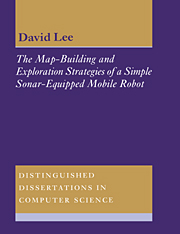 The Map-Building and Exploration Strategies of a Simple Sonar-Equipped Mobile Robot
The Map-Building and Exploration Strategies of a Simple Sonar-Equipped Mobile Robot Published online by Cambridge University Press: 05 March 2012
This chapter presents the sonar sensor model that was developed in this research. Figure 6.1 shows that the model is used to interpret the raw sonar returns from ARNE before the information is passed on to the the other modules on the workstation.
Section 6.1 outlines the operation of the Polaroid ultrasonic rangefinder used by ARNE. Section 6.2 then describes initial experiments to measure the range to a smooth wall in the test environment. The experiments highlight two key features of the sonar sensor: its wide beam and its uneven signal strength. Section 6.3 proposes a sonar model to mitigate the effect of these features by grouping neighbouring range readings. Section 6.4 then describes experiments to verify that the model will be applicable when measuring the range to the variety of objects that ARNE will encounter in the test environment. Section 6.5 then summarises the model.
6.1 The Polaroid Ultrasonic Sensor
Time-of-flight sonar is used in this thesis; distance information is derived from the time taken for a pulse of sound to travel to an object and be reflected back to the sensor.
Figure 6.2 is a simplified diagram of the rangefinder. Voltage pulses are sent to the transducer, which emits 16 cycles of square wave sound at about 50 kHz. As the sound begins, a timer is started. For a short period after transmission, the transducer is disabled (to give enough time for the vibration to die away) and it is then used to listen for an echo.
To save this book to your Kindle, first ensure [email protected] is added to your Approved Personal Document E-mail List under your Personal Document Settings on the Manage Your Content and Devices page of your Amazon account. Then enter the ‘name’ part of your Kindle email address below. Find out more about saving to your Kindle.
Note you can select to save to either the @free.kindle.com or @kindle.com variations. ‘@free.kindle.com’ emails are free but can only be saved to your device when it is connected to wi-fi. ‘@kindle.com’ emails can be delivered even when you are not connected to wi-fi, but note that service fees apply.
Find out more about the Kindle Personal Document Service.
To save content items to your account, please confirm that you agree to abide by our usage policies. If this is the first time you use this feature, you will be asked to authorise Cambridge Core to connect with your account. Find out more about saving content to Dropbox.
To save content items to your account, please confirm that you agree to abide by our usage policies. If this is the first time you use this feature, you will be asked to authorise Cambridge Core to connect with your account. Find out more about saving content to Google Drive.